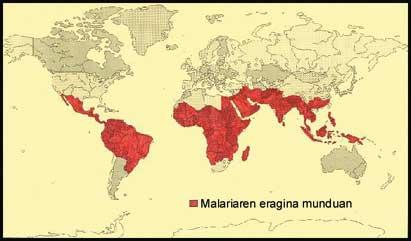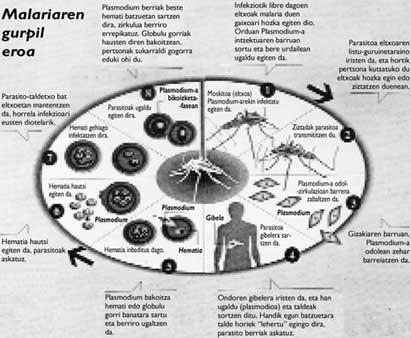Old vaccine, new subject
2004/09/01 Montero Carcaboso, Angel Iturria: Elhuyar aldizkaria
Remember that malaria vaccine that in the 1990s gave thousands of people and was not successful? Probably yes, and you may have heard with attention some lecture by the Colombian Manuel Patarroyo who created that vaccine. Patarroyo spoke of vaccines created by chemical synthesis and designed by reason.
That synthetic vaccine, called SPf66, was left without the help of the World Health Organization when it saw that it did not produce enough support. Then, the Colombian researcher went to the University of the Basque Country/Euskal Herriko Unibertsitatea to study the effectiveness of the vaccine by changing the substance used for distribution.
Clinical trials soon showed that the number of antibodies increased considerably by replacing the aluminium chamber for the distribution of SPf66 with a biodegradable polymer called PLGA. The trials were performed with mice and monkeys. The secret was to obtain micron-sized PLGA particles to introduce the vaccine and progressively release it to the animal's immune system.

The first objective of the research was, therefore, to improve the vaccine from a practical point of view, since one of the current priorities of the WHO is to reduce the use of syringes in countries with more cases of malaria, that is, in the most disadvantaged.
To avoid the use of needles there were two options: ingestion (by mouth) or inhalation (by nose) of the vaccine by the mouse. It was found that in these two ways of administering the vaccine, more antibodies were produced than aluminum injection, or at least the same amount. And in addition, the immune response was especially powerful in mice that received the vaccine through the nose, even stronger than that obtained under the skin, although the dose of SPf66 was equivalent.
But the vaccine against malaria is not only a matter of quantity but of quality, since it is of no use to create many antibodies if they are not able to recognize and neutralize the red blood cells contaminated by the malaria parasite. In the mouse this type of antibodies is known as IgG2.
When analyzing the serum of the mice, it was found that those inserted with aluminum did not include this type of IgG2, while those who received the PLGA vaccine did.
But there is a second quality feature of the immune response: Lymphocyte activity Th1. For detection, the interferon that flow when activated was measured. Only with a new strategy was achieved a desired level of interferon, by placing microparticles inside the skin, so that dendritic cells will detect them. Fortunately, new ways of vaccinating inside the skin without using syringes are being developed.
After all, although he passed the SPf66 train full of aluminum, many years ago, his subjects have made the way for the development of future vaccines clearer.
- Project title Microparticular systems to modulate and strengthen the immunity of the synthetic vaccine SPf66 against malaria.
- The goal is to improve the SPf66 vaccine through the PLGA polymeric support.
- Director José Luis Pedraz.
- Working group R.Mª Hernandez, M. Igartua, J.E. Roses, E. Mata, A. Montero.
- Department Laboratory of Pharmacy and Pharmaceutical Technology.
- Faculty of Pharmacy.
- Financing UPV.
Basque Research/Thesis Award 2004

Gai honi buruzko eduki gehiago
Elhuyarrek garatutako teknologia





